ELSINORE TOURIST OFFICE - Stengade 59 - 3000 Helsingør - OPEN ALL YEAR - Tel. + 45 49 28 28 28 - Mail: kepo@helsingor.dk
station
Elsinore walk starts at Elsinore railway station
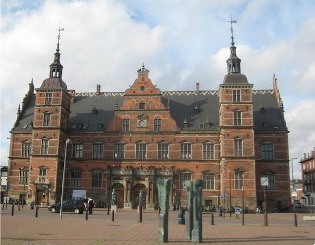 |
| Elsinore Railway Station |
Railway Station Square 1 GPS: 56.033804, 12.615003
Elsinore railway station is known as "the country's most beautiful railway station" since it was built in 1891. It is still Elsinore hub for both buses
ferries and trains. Outside stands Hamlet and Ophelia who invites travelers welcome to Hamlets city and Elsinore Walk
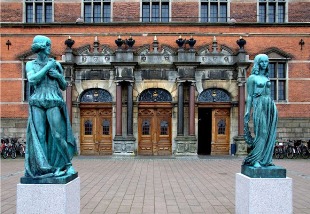 |
| Hamlet and his beloved Ophelia |
The square in front Elsinore Harbour and Railway Station, has since time immemorial been the city's natural arrival point. Here was originally a beach, with its white sand and dunes eventually gave its name to the nearby Strand Street. Later a traditional waterfront with marina office and warehouses. This may, however, in the 1890s to give way in favor of it was called "The country's finest railway station", the character of the contemporary leading Danish railway architects N.P.C. Holsøe and Heinrich Wenck. the Station building is today worth preserving, but the area around the station and the port continues to function as the city's transport hub.
The site has also always played an important role in the city's history, which has been concentrated into two eras: Sound Due Periode (1429-1857) and Boatyard time (1882-1983). Today known Elsinore in the world as a modern cultural city with the nickname "Home of Hamlet" by William Shakespeare's famous play, which takes place at Kronborg Castle in Elsinore.
Therefore featuring Hamlet and his beloved Ophelia, of course, welcome to the city in the form of two sculptures by Danish artist Rudolph Tegner (1873-1950).

Harbour Square
 |
| Harbours Square and Sveasoejlen |
Jernbanevej GPS: 56.034338, 12.614821
From Station Square, crossed over to Harbours Square and Sveasoejlen which is a 11.75 meter high, shining monument, which is composed of 11 copper pillars that are performed at Elsinore Shipyard, with capitals (head) of bronze. The head is made by sculptor M.S. Elo in 1947 to commemorate Sweden's aid to Danish refugees during World War II.
Among other things, took Sweden in October 1943 against the 7000 Danish Jews. Most were smuggled into fishing boats from the coast of Elsinore, where the Sound is narrowest. When darkness falls, lights "the head of Sveasoejlen) up in memory of the bonfire greeting that despite the blackout, was exchanged from coast to coast every Christmas Eve in the war years 1943-1945.
On Harbour Square, you will also find Elsinore Tourist office,
Elsinore Tourist office access often seem well hidden behind the flower market.
The customs office where you find Elsinore Tourist Office, also houses a cultural center with the music scene, children's culture center and a café. Please make it worth a visit.
The inscription on Sveasoejlen reads:
Peace and justice must give way to power and Violence 9 April 1940. But rank was the Danish king and people under the Occupation ". "War split the Nordic region, but Heart ties between the Nordic remained and Christmas bonfire Flash Greeting shone across the Sound from coast to coast and from heart to heart." "With Broderhaand and Friends minds gave Sweden salvation to the Danish Refugee and equipped the Danish Brigade who came to Elsinore on Freedom Day May 5, 1945
". "The Resistance Will meant freedom struggle against foreign Violence in Denmark until the victorious powers armies liberated our land"
Harbour square is bordered by Elsinore's Latin Quarter and Toldkammeret with the Tourist Office. Across the square stands Sveasøjlen in memory of Sweden's aid to Danish refugees during World War II.'.

 |
Old chandlers yard
 |
| Old chandlers yard |
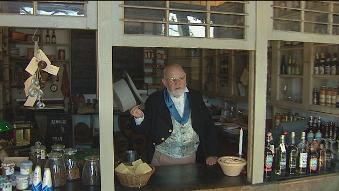 |
Strandgade 91 GPS: 56.034715, 12.615121
Continue across the harbor square and turn right onto Beach Street (Strandgade). The route now goes through
old Ferry Street (Gl. Faergestraede) but continue at first like a little longer to museum Old Sound Dues building
(Skibsklarerergården)..
Beach Street 91 (Strandgade 91):
Rasmussen's Yard was built in 1637 by toldvisitør Christen Rasmussen. Anchors in the facade form builder and his wife, Kirstine Oluf daughter, initials.
The building is today known as Old chandlers yard (Skibsklarerergaarden) and the museum of the Sound Due period. Here is include a shop that sells "original" items. In the courtyard, as in 1700 a small brewery that produces the in-house beer.
In the well-preserved house with interior from 1780, one gets a vivid impression of what it looked like when ships from around the world supplies ready and paid their Sound duty.
It is also possible for the tour of the rest of the house.
Sound Dues was one of Denmark's most important revenue sources from the introduction of Erik of Pomerania in 1429 for the discontinued in 1857. The payable of every ship that passed through Danish waters.
Elsinore walk now go back to Old Ferry Street (Gl. Færgestræde), which in 2009 was recreated, as it looked in the Middle Ages with, among other maladjusted field stones. The Street was originally established as one of the links between ship bridges on the beach and the main street of the then new city whose strategic location at the gateway to the Sound secured progress and growth through international trade relations.
Street names in Elsinore says, as in other cities, a good deal of cultural history. In the medieval street grid was Old Ferry Street (Gl. Færgestræde) the street that led down to the ferries.
The owner of Stengade 66, let supposedly Old Ferry Street (Gl. Færgestræde) cordon off in 1746 to use it to "poultry yard, toilet and Pigsty". Despite the city council's incessant complaints remained the Strait closed for nearly 100 years. It was after closing, called "the closed Strait" until the reopening of the 1911th
When chickens and pigs rummaging in the waste that residents threw out, one can imagine the stench, and Elsinore many plague epidemics can safely with the numerous foreign seamen presence attributed to the paradise that here was created for rats and other disease vectors.
Note among other things, the fine old lamps and the Low German inscription above one of the doors. It recalls that in the old days could buy wine by the pharmacist.
At the corner of Stone Street (Stengade 66) and Old Ferry Strait lies Elsinore's oldest preserved house, called Oxernes yard. Also this house has a rich history. Oxernes yard, built in 1459 by the vassal of the fortress Krogen, Johan Oxe. Later the house was inhabited by "the Danish written language's father", Chr. Pedersen, in the first half of the 1500s as the first translated the Bible into Danish. Note the stepped gable of the original building.
A little to the left, Stengade 64, you see Dahl´s merchant's house. Here we see a very fine example of Baroque style. The house was built by merchant Nicolai Dahl in 1739 and appears largely as the time of construction.
Handicapinfo:
disabled recommended to go along Brostræde 
.
THE TIBBERUP MERCHANT
Don't miss :
Elsinore international speaking MERCHANT 1922
Set time back 100 years And enjoy the scent, Here you can buy natural linen shirts In all colours, Original Fisherman Sweater´s - Brushes For scrubbing the back And all kinds Of soaps by the kilo
If you need rope For the schooner Or a handle For your cupboard doors from 1864, TIBBERUP HOEKEREN has that too.
Or you can just enjoy The Ovners's warm welcome and let yourself be lost in a bygone culture.
TIBBERUP HOEKEREN
Sct. Anna Gade 4A
3000 Helsingor
CVR 15800038
Telefon +45 49 17 04 24
info@tibberuphoekeren.dk
https://tibberuphoekeren.dk/
Åbningstider
Maritim Clothes And ropes
 |
| Welcome |
At THE TIBBERUP MERCHANT you will find maritime clothing brands And quality you won't find anywhere else. We want to offer you classic clothing based on traditional work clothes. This means full mobility and spaciousness in the clothes - no 'slim-line'. In addition, the materials must be comfortable to wear.
All our clothes are produced In Europe, primarily Portugal, by small manufacturers. Portugal has a Long history In clothing production And are world champions In handling cotton And wool. It can both be seen And felt When you hold the materials.
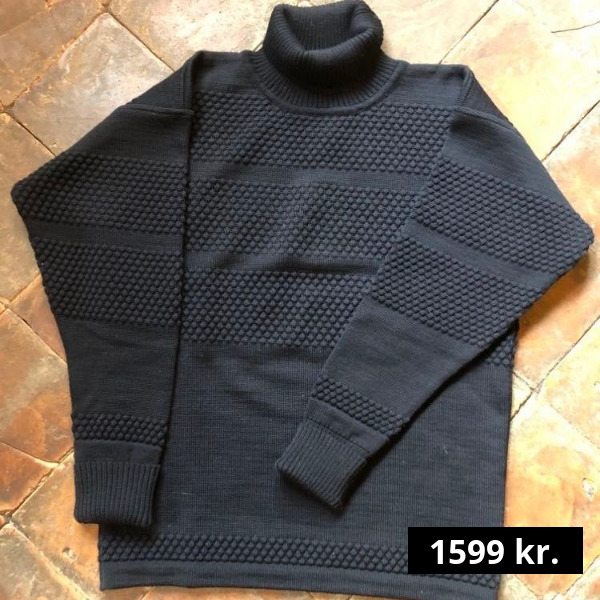 |
| Fisherman Sweater |
The fit Is different from contemporary clothes And you will find clothes In our store In Helsingør that we unfortunately cannot offer In our webshop.
Here you will find all the good things For yourself And the family. We import ourselves so we know the manufacturing method And the contents Of the goods. We Try As best we can To explain what exactly the individual soap can And should be used For. If In doubt, just write. We will have To answer.
Wool moth Or clothes moth - animals With many names
in Clothing, Guidance/by Nanna
Get rid Of the moths that destroy your woolen clothes Or silk shirts. Wool Is very picky, so the better the quality, the more you are sure they will come through. Read here how To Get rid Of the moths And how To avoid them In the future.
Ideas For the different gifts
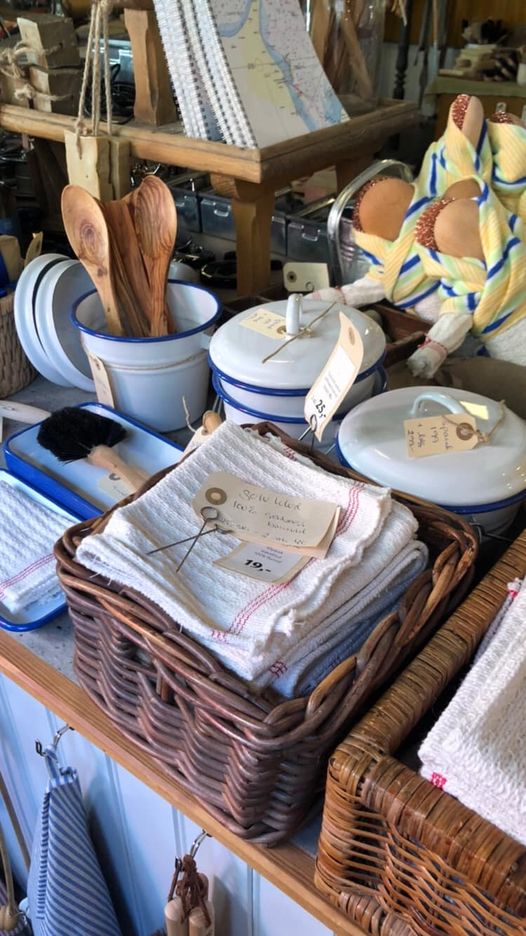 |
| Ideas For the different gifts |
Here you will find gift ideas For both him And her. We have categorized it by price, so you have To look around And see If you can use any Of it. You can also find package game packages For various package games at home Or at work. You'll find things and cases divided by price, so it's quick to get an overview..
How To take measurements For your sailor blouse:
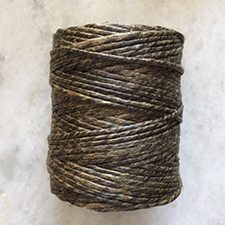 |
| Styrke, Kvalitet og Sjæl |
Tar - Work & Kit
Tibberup Høkeren sources its pigments, If possible, from producers And suppliers around Europe. Most often, these are small family businesses that have worked With the production Of dry colors And pigments For generations And therefore know what they are doing.
You can also find more inspiration in our webshop
 |
Old Sound Dues building
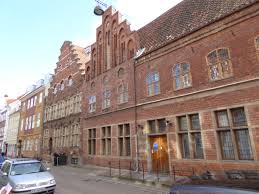 |
| Old Sound Dues building |
Stengade 72 GPS: 56.035165, 12.614263
The beautiful 1500 century stone houses, and Old Sound Dues building extends
in Stengade from no. 64 to 76. They are buildings from a time when Elsinore in great style built its growth on international
trade with Sound Dues .
Elsinore actual story begins with Erik of Pomerania, which is considered the city's founder. First of all because he let this city be collecting place for the Sound Dues, and in 1426 had Erik of Pomerania granted the city a special city charter and a transition was Elsinore, Denmark's second largest city. Erik of Pomerania had forced the city's development by imposing townspeople "their city to build, multiply and improve with good market town buildings".
To reach the goal, lured the king of tax cuts: if you Built your house in stone waited 10 years tax exemption. (Those who built wooden, relax only to pay taxes for five years!) Houses are built while King Frederick the second was started with the construction of Kronborg Castle. And it is clear that the houses are built with the assistance of the same foreign craftsmen who built for the king.
The buildings in Stengade 72 and 74 called Lejlernes yard. They were for years owned by the Scottish noble family leyel, who had a great influence in the city. Two members of this family, father and son, were both mayors in Elsinore.
The Sound and thus the city Elsinore had a strategic key position with the ability to control all entry and exit for the entire Baltic region, which has been of utmost importance far back in time. It was the shortest route to the main trade route for centuries, an important link between west and east from very early times, already known and used by Vikings as a trade route for commercial sites on the southern shores of the Baltic region.
 |
| Elsinore 1582 after Hans
Knieper |
Ships became bigger, more spacious and could go further. The international competition for trade, power and position increased over the years for supremacy of the Baltic Sea. Enforcement and maintaining domination was an important issue, and it had to come to trials of strength between countries, in extreme cases, in the form of war. Here could Elsinore position have the negative effect that it was a focal point in these disputes.
Frederik 2. put Peter oxe (from the genus oxe see Oxernes yard Stengade 66) to raise more money in Duty customs box. Sound Toll was at beginning a rose nobel per. ship, but Peter oxe changed duty to cargo customs instead. It filled very well in the king's private box and could be used to finance castles (Kronborg example) and wars, that swallowed a lot of money. Very smart it was, because the ships were larger, could go further and carry more cargo and specific products, all contributed to higher revenues. Greeted a ship correctly or attempted a ship failing to pay, The King were fired warning shots either from Kronborg or guard ship in the Sound. The incident was followed by "pay a fine" shoot money for guns and bullets.
In 1857 the Sound Dues was abolished after international pressure on a trade conference and an offer of compensation of 33.5 million. dollars (67 mill. kr.) from eg USA.
Note in Stengade no. 72 of the facades stone rimmed windows and the crenellated gable at no. 74. During the facade makes a limestone bands with gothic font and text in Latin: "My redeemer lives, and at the last day I awakened the earth and in my meat see God my Saviour ". The horizontal profile bands have come to the Renaissance.
At number 76 we find publican David Hansen's property. The facade here is equipped with sandstone bands and colorful decorations. Over the windows are a series of small busts of ideal heads. Two of the busts, carried out as portraits of, respectively, a man and a woman carrying suits from Frederik 2.s time. Publican David Hansen's farm, built in 1579 is a well-preserved bourgeois renaissance. The publican never lived even in the house, but rented it out to Christian IV's economic adviser, Jonas Charisius.
Handicapinfo:
Turn from Stengade at Sct. Anna Street to the yellow house Sct. Anna Gade 6 and mural

St. Olav's Church and Elsinore Cathedral
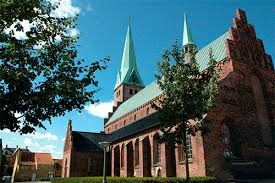 |
| St. Olav's Church and Elsinore Cathedral |
Sct Anna Gade 12 GPS: 56.035752, 12.613555
St. Olav's Church and Elsinore Cathedral got its present form back in 1559 and could thus celebrate 450 years anniversary in 2009. The oldest walls of the church are from the 1200s.
The first church was erected here in what at the time was the beach at the former earhook. The church is named after its patron saint, the Norwegian viking king and national saint Olav the Holy, as both total and Christianized Norway. When Erik of Pomerania introduced the Sound Dues began Skt. Olav's Church a transformation.
 |
| Helsingør set fra sydvest. Midt i billedet Kronborg, til højre Sankt Olai Kirke med det lange spir, mens Sankt Mariæ Kirkes gavl anes til venstre for Kronborg. |
The Church should match Elsinore's growing importance for the country and have therefore been extended several times. Since 1961, St. Olav's Church had the status of cathedral as northern Zealand was spun off as an independent diocese.
Sct. Olav's Church, Elsinore Cathedral, is in its origin one nave, Romanesque brick church built in the period 1200-1250. In the north wing can be seen 20 m. Masonry from the original building. Around 1560 the church had much the appearance it has today; but in a period from 1615, the church had an impressive over 50m high spire called "Elsinore virgin." It blew sadly down in 1737.
On the east wall of the church, a panel, which shows down to a vault. Above it, is a skull, the symbol of death. The French text reads: "Thus we are all".
Within the church dominated by a 11.5 meter high altarpiece from 1664. The board is composed of 19 reliefs depicting the life of Jesus. In addition, a treasure of Renaissance and especially Baroque works. For example the pulpit from the 1567th
 |
| Sct. Annagade 6 |
Elsinore Cathedral is the place where the city's first church was built over 800 years ago. You are welcome, Go on in.
Go from the church against the yellow house and the large mural facing Sct. Anna
Street. In the yellow house, located in Sct. Anna Gade 6, but which also has facade toward the church grew composer Diderik Buxtehude (1637-1707) up. He was in the years 1660-1668 organist at St.. Mary's Church and became known as one of 1600 century most important composers that inspired names like Johan Sebastian Bach and Georg Friedrich Händel.
More about Buxtehude
The painting on the gable of the house of Buxtehude in Sct. Anna Gade, portrays Sound duty period. It shows contemporary cosmopolitan, rich and very vibrant market town, which for over 400 years lived from the many ships that had to pay the Sound Toll.
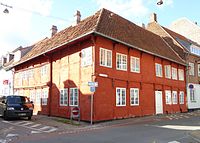 |
| Captain Karlsen |
Now look up the Sct. Anna street, the red house on the corner of Sct. Olav
street, "Mermaid" at the corner of Sct. Olaigade and Sct. Anna
street. This location, the quirky rooms and interior, were used to produce of the popular Danish film "Captain Karlsen" (1958) from which we know the country well-known actors "Dirck Passer" and "Budil Utsen" with "Flute barrel Viktoria" which actually was "Bodil Udsen's" career first big hit -song and breakthroughs, "Flute barrel Viktoria" song "Bodil Utsen" first time in Elsinore Revue in 1956th
Read more in this great Pdf Folder about Elsinore Cathedral
(English)
Elsinore Cathedral Sct. Annagade 12 - 3000 Helsingør
The church is open on weekdays. 10 – 16 (maj – aug.)
- - kl. 10 – 14 (sep. – apr)
Note - lunck break! You are now between points 5 and 6. Have you decided to take the whole trip in one day, continue to point 6, but is hungry by joining, you should be aware that you are now moving away from the City area where you will find the best restaurants and eateries. You have
 Sct. Olai gade just to the left of the red house with several restaurants. best restaurants and eateries.
Sct. Olai gade just to the left of the red house with several restaurants. best restaurants and eateries.

Elsinore City Museum
 |
| Elsinore City Museum |
Sct Anna Gade 36 GPS: 56.036310, 12.612653
Elsinore City Museum is housed in a building that itself is a big attraction.
Hospital, citizen's house, horse mill vassal housing, grammar school, poorhouse, public library. It is the features that the current City Museum has been the setting whether, after Christian 2 in 1516 gave the Carmelites permission to build a hospital for sailors.
In 1550 the building was purchased by the vassal of Kronborg, Skåne nobleman Trolle and his wife Birgitte Gøye, known as the founders of the boarding school Herlufsholm Næstved. They decorated the building to near a manor house in the middle of Sound Due city.
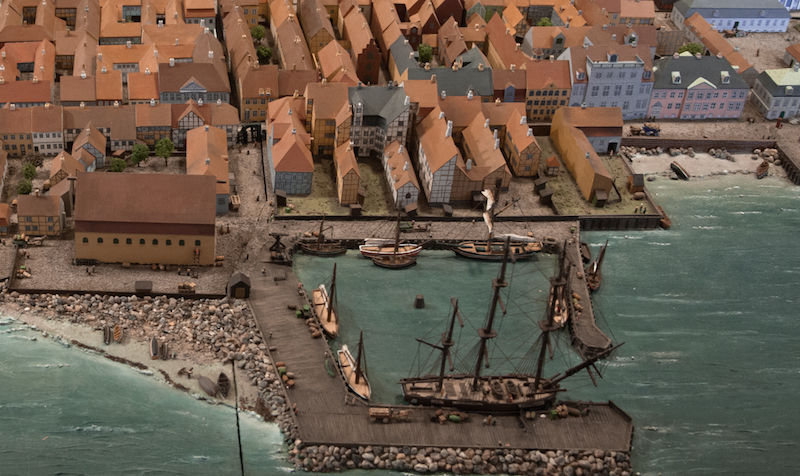 |
| Elsinore City Museum model of Elsinore city anno 1801 |
The couple moved However, from the town, and the building was subsequently used among others as a grammar school. In 1630 the city took over the property, and the former millionaire property was refurbished to the poorhouse instead. This feature had instead until 1902 when the buildings gradually became so dilapidated that the house - also because of its role as a poorhouse - was called "terrors House".
It was therefore in a transition to talk to tear the house down, but cultural awareness prevented that this happened. Instead, the building was restored, and in 1911 moved Elsinore Historical Museum and the Public Library in.
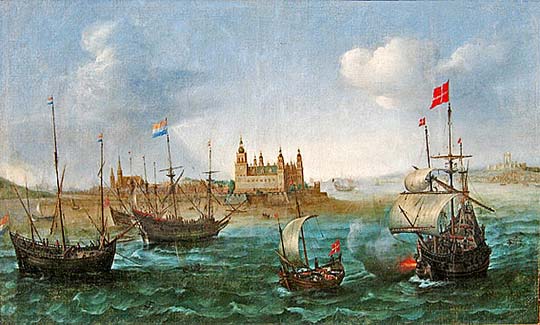 |
The library was located in the building until 1973. You are welcome in the museum. Here you will find a treasure trove packed with stuff that tells the story of the city's past - in both the permanent and temporary exhibitions. You will include a model of Elsinore and Kronborg Castle, showing how
the city and especially the world-famous Kronborg castle looked in 1,801th
Elsinore was severely weakened by the war and plague in the early 1700s and even in 1735 there were only about 3400 inhabitants. The time now is for the city, as in the whole of a period of recovery that will last the century. The period known as the golden period and refers to an increase associated with increasing foreign trade and to a lesser extent a business development.
For Elsinore it is first and foremost a higher earnings and revenue as a result of an increase in through navigation in the Sound. This can be illustrated with a number of key figures. In the 1500s passed hardly more than 300 ships in the 1600s 1500, while 1750 were approximately 5000 ships a year, in 1790 about 10,000. During the Napoleon war, falling the number catastrophically, while in 1840 adds up to over 20,000 ships annually. The revenue of the Sound Dues, which until 1771 went directly to the king's private box was in the 1730s at about 200,000 dollars annually in 1780-1790erne of 500 to 600,000 dollars.
 |
| Erik af Pommern King of Denmark, de Venders og Gothers |
A brand new officialdom appeared around the collection and administration of the Sound Dues and increased in parallel with the growing number of ships. There was a fairly large group of military personnel attached to Kronborg. The many ships contributed to many seamen stay in the city. Many nationalities were represented in the city. The ships created a rich commercial for a lot of business men of various kinds at different levels: small merchants, ship chandlers, the city's main business; few merchants, wholesalers, ship agents, later consuls, who were often quite influential
In Elsinore City Museum you can see an amazing collection of building elements that represent 800 years of construction in Elsinore area. Here are handmade nails and screws, meticulously crafted window fittings in various forms, finely profiled window sills, frames and doors and hand-printed wallpapers - all made of the city's craftsmen for centuries. Here are tiles of all types at all times, tiles from Gurre Castle and large bricks with traces of the animals 400 years ago has trudged across the still wet stones.
Elsinore City Museum Sct. Anna Gade 36 3000 Helsingør Tel.
+45 4928 1800
HOURS: Open all year, Monday, Closed - Tuesday, Thursday and Friday:. 12-16 Wednesday: pm. 10 - 20 Saturday:. 10-14 Sunday: pm. 12-16

Sct. Mary's Church and Carmelite Monastery
 |
| Sct. Mary's Church Elsinore |
Buxtehudes stræde GPS: 56.036723, 12.612879
Sct. Mary's Church with Carmelite Monastery is one of Northern Europe's best preserved monastery from the Middle Ages. And the doors are open during the day, you are welcome then go on in.
The monastery was founded in 1430, shortly after the Sound Dues and Its introduction as Erik of Pomerania invited Carmelite monks, the so-called white brothers to Elsinore.
Church and monastery was completed in its present form around the year 1500th
After the Reformation, the monastery was in 1541 converted into a hospital and retirement home.
In addition, the monastery has been Elsinore grammar school and in the 1800s served as a retirement home for the needy.
Discover how everyday sounds and worries displaced by an inner harmony. When you stand there in the intersection, where you can choose to go one way or the other way round the green cloister, it is as if your shoulders fall down, and you can take a deep breath.
Since 1991 the monastery buildings has been used as an administration building for Elsinore rigid magistrates and meeting rooms for Sct. Mary's parish.
Inside the church, the floor is covered with numerous, partly worn tombstone, dating from the time when it was possible for wealthy citizens to acquire a tomb in the church.
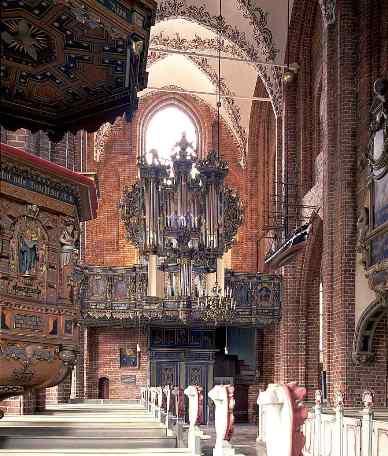 |
| Sct. Mary's Church organ |
After the Reformation, the church was first deserted. Later it was used as a travel barn. The project was about to tear down the church, but since there were many foreigners in the city, Frederik left the second to the German initiate foreign congregation. And from 1576 was here only preached in German. In 1851 they heard German sermons full, but the many German inscriptions testify to the long term as German church.
The church, together with the monastery was thoroughly restored in 1900-1907 by architect and professor H. B. Storck, can showcase many of its original frescoes and an interior that for the most part is donated to the church in Frederick II's time. Which is a big attraction, especially church organ, dating from 1662-63, where the organist was the very famous composer Diederich
Buxtehude.
In 1854 and again in 1959-60 to be greatly altered and rebuilt, it again recently has been lovingly restored and partially reconstructed so that today it appears as in Buxtehude's time. The organ concerts organized in the church, is quite a unique experience that attracts a large audience.
Read more about Buxtehude
History:
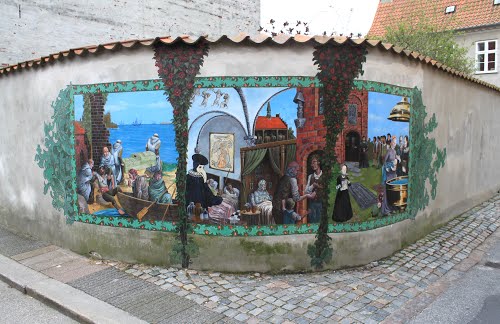 |
| Murmalerierne er udført af de to
italienske kunstnere, Lara Atzori
og Piercarlo Carella |
The tour now goes to the corner of Kirkestræde and Hestemøllestræde where a mural depicting
tels three important periods in Elsinore and church history.
Left image symbolizes the Middle Ages, when monks helping a sick sailor ashore.
The closed box is for the transport of sick and infectious persons.
The middle image shows how Our Lady Monastery after the Reformation was used for the hospital. A doctor is centrally located with the classic mask containing herbs in the nose to avoid infection. One also sees how Sct. Mary's Church after the Reformation was used to corral until it was donated to the city's German-speaking community. Nobleman Trolle stands in the doorway of the former Karmeliterhus, which today is Elsinore City Museum.
The building has as mentioned been poorhouse. Therefore, we see a wretch and his child stand by the door and beg.
Right image is about Elsinore after the Reformation. The town's parish church St. Olav form with his patron over the door, the Norwegian king Olav the Holy, background. A Lutheran pastor welcomes. A child is baptized and among the people seen reformer Martin Luther. In contrast to the new life seen the cemetery with the graves.
Sct. Mary's Church and Our Lady ABBEY Sct. Anna Gade 38 3000 Helsingør
Tlf. +45 4921 1774 www.sctmariae.dk
HOURS: Open all year. May 16-September 15 Tuesday to Sunday. 10-15 September 16. to 15 May, Tuesday to Sunday. 10-14

Note - lunck break! You are now between
point 7 and 8. Have you decided to take the whole trip in one day, continue to point 8, but is hungry by teasing, you should be aware that you are now moving away from the City area where you will find the
best restaurants and eateries.
Brewery Wiibroe
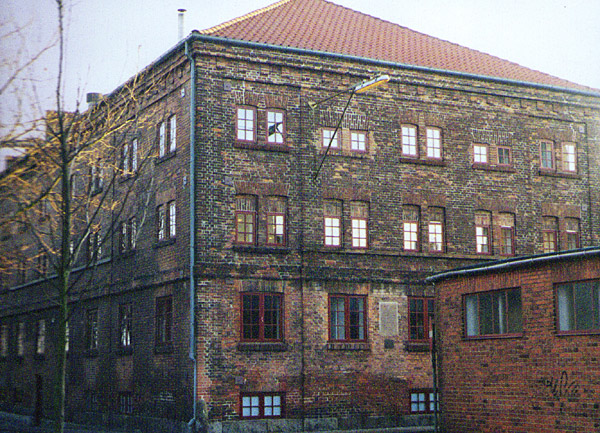 |
| Wiibroe Hestemøllestræde |
Hæstemøllestræde 14 GPS: 56.036681, 12.613909
At the corner of Hestemøllestræde and Sophie Brahe Street was previously a farm inhabited by the Danish scientist Tycho Brahe's sister and research assistant, Sophie, as the street was named after. The farm burned down in 1860 and in 1862 built the brewer Carl Wiibroe brewery Wiibroe here that after the Sound Dues elimination was one of the city's large company with many jobs
. . . more
about Tycho Brahe
Elsinore had with its international fame and its cosmopolitan touch in front when it came to new initiatives and fashion in many respects. The ships were forced to dock in order to pay the Sound Toll. Shipping and trade in the passing merchant ships from all countries was the foundation and lifeblood of the town of Elsinore.
Life at sea could be quite hard, both in terms of weather conditions and general convenience. Putting into town gave the opportunity to rest, have fun and act after many days at sea.
Goods swapped ship and ship between, and common customs market was popular. Here was traded with all items.
This market was revived in August 2013 in a modest form and was so successful that it is now an annual recurring event in Elsinore. Read more about Sundtoldsmarkedet
Helsingør
There could be as many as 300 ships in Elsinore port, when there were as many ships. Sailors and soldiers from the garrison of Kronborg filled well in city streets, often very thirsty, often very drunk. Around 600-900-commissioned officers and ordinary soldiers could be firmly linked to the military and were staying private until 1785, where a barracks was set at Kronborg (discontinued in 1924, the military disappeared, however, only completely in 1991).
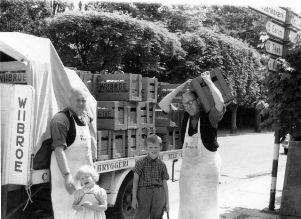 |
| Wiibroe beer |
 |
| Mural Hestemoellestraede |
1840 was the year when there were only recorded three brewers in the city. Among these three brewers, we find Carl Wiibroe, founder of Wiibroes Brewery.
Carl Wiibroe had just taken over Chr. Jeppesen's small but well-known white beer brewery in
Stengade 82
As a business degree had Carl Wiibroe hardly the beginning not the very best knowledge of the noble brewing, but it was not needed even to make contemporary ship's beer and poor man's beer.
Already in 1851 began Carl Wiibroe brewing bottom-fermented beer. The effort succeeded only when he after long and arduous negotiations got permission to establish storage cellars in the cold violence basements or casemates of Kronborg underground.
On January 26, year 1856 announced Carl Wiibroe for the first time its new beer type. It cost four shillings half bottle and "Wiibroeren" immediately fell in the buyer's taste.
Carl Wiibroe had already in early summer of the following year to report all sold out. The following year it managed Wiibroeske brewery to brew 750 barrels. Bavarian beer in the modest premises in
Stengade 82.
In 1861 acquired Carl Wiibroe the "Sound Society" burned property on the corner of
Hestemøllestræde and Sophie Brahe Street. By Brothers help, the renowned architect Chr. Holsøe, the ruins were transformed into a brewery and malt house. Jeppesen's old brewery in
Stengade be decommissioned in 1862. The cellars were however retained for storage and bottling.
Engine power was installed in the company in 1872, and six years later a new storage cellar building with overlying ice bunkers are used. In this way, the production of Bavarian beer, which soon became the brewery's most essential product, expanded and improved.
By persevering struggle with many difficulties, not least economic, drives Carl Wiibroe the original small brewery at a quite sizable and modern enterprise. Read more about Wiibroe

Culture port Kronborg
 |
| Culture port Kronborg Elsinore |
Culture port Allegade 2 GPS: 56.037742, 12.614660
Welcome to Culture Harbour Kronborg, Elsinore's new urban waterfront view of Sweden and the ferries back and forth between Elsinore and Helsingborg.
Where once there were produced ships are now being traditional knowledge and experiences to the people. The ambition has been to make Culture port Kronborg to a diverse and unique universe with attractive locally, regionally and internationally. One arena in which culture, architecture and history mirror each other in terms of the Culture Yard, National maritime museum, Kronborg Castle and harbor.
Every year, the port is setting for a wide a range of events that visitors can participate in. Everything from large outdoor concerts to Hamlet theater, guided tours, treasure hunts and fun run.
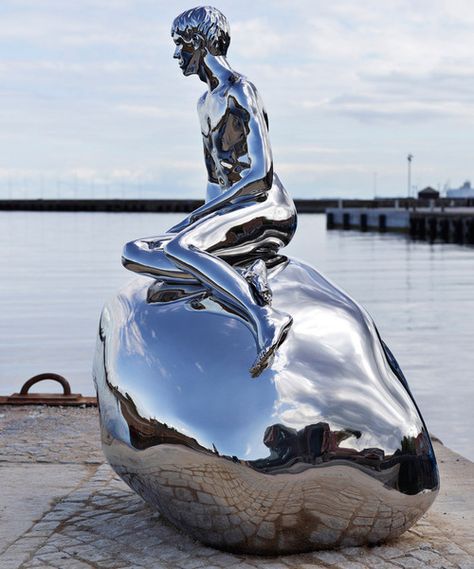 |
But the large square in front of the Culture Yard can also be used simply to relax and enjoy life.
At the end of the pier in front of the Culture Yard will find the sculpture 'HE'. The young male figure in polished steel created by the world renowned artist duo Elmgreen & Dragset, and has become a landmark of the diversity of Cultural Kronborg and Elsinore.
With his posture and his delicate expression is 'HE' a clear reference to Edvard Eriksen's sculpture 'The Little Mermaid' at Langelinie in Copenhagen. 'HE', which was unveiled in 2012, testifies to the development that has happened since 'The Little Mermaid' was born. And now heralds 'HE' new, post-industrial times. Also see Copenhagen Pride
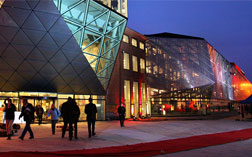 |
| Kulturværftet Helsingør |
Culture Yard Allegade 2 GPS: 56.037742, 12.614660
Past and present meet in architecture at the Culture Yard, designed by the architect AART architects. From the outside gives the sail-inspired facade of glass, steel and building envelope a modern and sculptural expression.
Inside the old shipyard buildings preserved as a historical core. Here is the bare concrete walls, exposed ceiling beams, magnificent window parties, balconies facing the harbor, rooftop terrace with views of Kronborg and hooks with exquisite views.
the Culture Yard opened on 10/10/10. pm. 10.10. The number of visitors has since been steadily increasing to over 700,000 guests.
Every year there are more than 1,000 events, and over half of cultural events.
The large modern library in the heart of the building was in 2015 named one of Europe's best and is an experience in itself with exhibitions, stunning views and an entire floor dedicated to children.
The modern culture yard puts scenes and space for a wide range of local, national and international cultural events.

 |
M/S Museet for Soefart (The Danish Maritime Museum)
Ny Kronborgvej 1 GPS: 56.038977, 12.615840
Can you not see the M/S Museum Maritime ( The Danish Maritime Museum)? Then you are not the first. For the award-winning, iconic museum, designed by the world famous Danish architect Bjarke Ingels, below the earth's surface. So look down you are
very welcome!
M/S Museum Maritime (Danish Maritime Museum) has since its opening in 2013 has been one of the most talked about museums nationally and internationally.
The museum, which was designed by the Danish architect Bjarke Ingels "Architect design studio BIG", is located in Elsinore Shipyard old dry dock, which thus has been preserved as a historical monument to industrialization.
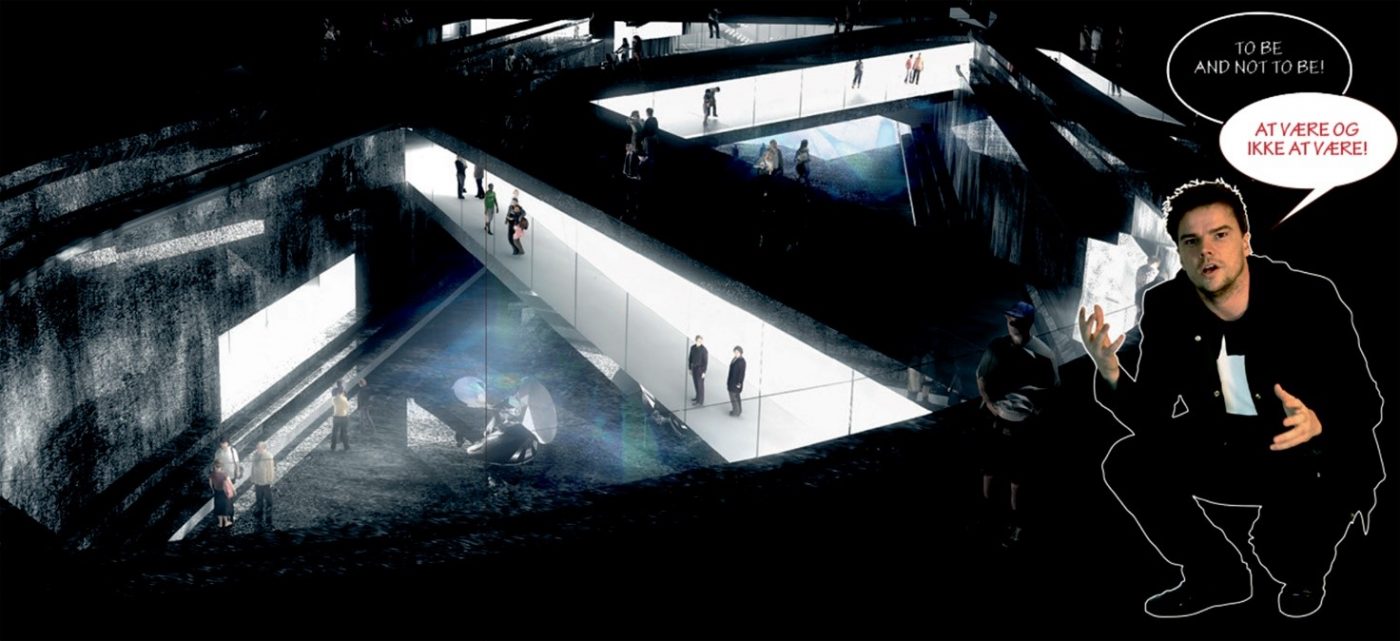 |
| The story of the Danish star architect Bjarke Ingel: |
BIG dock
BIG dock is the Maritime Museum's new permanent exhibition, which gives visitors the opportunity to get up close to star architect Bjarke Ingels' considerations, visions and creative process surrounding the creation of the already iconic underground museum building that Denmark's Maritime Museum has for houses in.
In the exhibition, the story is told by Bjarke Ingels himself – through films, statements, models and one of his favorite media: the comic book. Here Bjarke Ingels lifts
Among other things, the mystery of why he deliberately chose to break the competition rules to turn the dock inside out - and what magic happens when a historic industrial monument -
dry dock – gets new life through modern ground-breaking architecture.
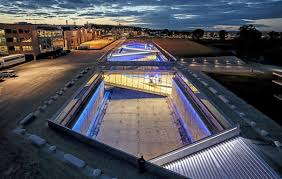 |
| Elsinore Shipyard old dry dock |
Admission to the museum is via the bridges that are stretched out over the dock. Follow the sloping bridges into a colorful world with scores of exhibits that tell of Denmark as one of the world's leading maritime nations in the past and present.
The museum's rich maritime collections is told through evocative and dramatic exhibitions of film, interactive games and personal accounts.
 |
| Søfartsmuseet Helsingør |
Here you can watch, listen and actively explore the maritime world. You can also take a break in the museum's cozy M / S Café.
The museum is built as an underground room that has been for using 3Dmodellering and innovative steel and concrete structures. A total of 461 ground anchors protrude 40 meters into the ground to keep the base plate in the whole museum in place, then ground water not pushing the building up of its hole.
In the dock courtyards sticking anchors up as nails like iron sticks and serves both as a technical solution and an architectural concept. These solutions consultancy company Ramboll behind, and is called the engineering of worldclass.
Your life depends on shipping. The world is dependent on sea. It has always been like that. Via shipping and trade and cultural influences that are part of Denmark, has always been tied together with the rest of the world. It is the history and the present that is unfolded on M / S Museum of Maritime.

KRONBORG CASTLE – FORTRES
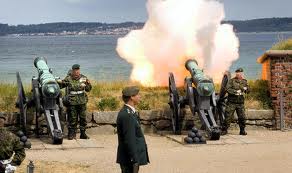 |
| Fortres Kronborg Castle |
Kronborg GPS: 56.039133, 12.616730
Kronborg is surrounded by a huge defense system, which in its time did Kronborg to one of Northern Europe's strongest fortresses.
In recent years, large parts of the fortress complex has been recreated, so it again can be seen in its full extent.
History Route: The route goes around the castle (see the dotted route on the map). On the tour you can feel fortress of walls and bastion of the force.
In the old barracks buildings are decorated shops, workshops for artisans, cafes and restaurants. A mobile guide can be followed around the field, and in the old gunpowder house there is an exhibition about the fortress installation history.
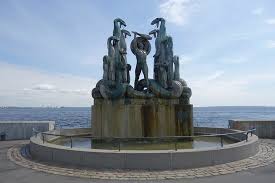 |
| Herakles against Hydra Elsinore |
Queen's Bastion: - play and picnic on the Queen's Bastion you can let your imagination and playful child away at Kronborg fortress playground for small children. There are also tables where you can enjoy your packed lunch in royal surroundings.
Heracles and the Hydra: At the end of the north pier stands the artist Rudolph Tegner statue of Hercules and the Hydra, which was completed in 1932.
Det kræver en omvej langs voldene ved Kronborg eller en tur henover Scholtens ravelin, at nå ud til den, men det kan varmt anbefales.
Herakles was the son of Zeus and the greatest of all Greek mythical heroes. To secure a place on Mount Olympus would he kill water monster Hydra. Herakles went on the attack with his sword, but for each head he cut off, grew three new forward. It could only go wrong. Citizens in Elsinore gave the sculpture its own nickname: "The little man's struggle against the tax authorities".
Kronborg Castle - Hamlet´s Castle
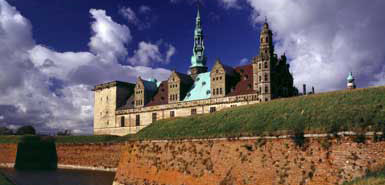 |
| Kronborg Slot - Hamlet´s Castle |
Kronborg GPS: 56.039133, 12.616730
Hamlet and Elsinore
On a dark winter night, a ghost walks the ramparts of
Elsinore Castle in
Denmark, and was discovered first by a pair of watchmen, later by the scholar
Horatio, the ghost resembles the recently dead King Hamlet, whose brother
Claudius has inherited the throne and married the dead king’s widow, Queen
Gertrude.
When Horatio and the watchmen told Prince Hamlet, the son of Gertrude
and the dead king, to see the ghost, the ghost speaks to him, declaring
ominously that it is indeed his father’s spirit, and that he was murdered by
none other than Claudius. Ordering Hamlet to seek revenge on the man who usurped
his throne and married his wife, the ghost disappears with the dawn.
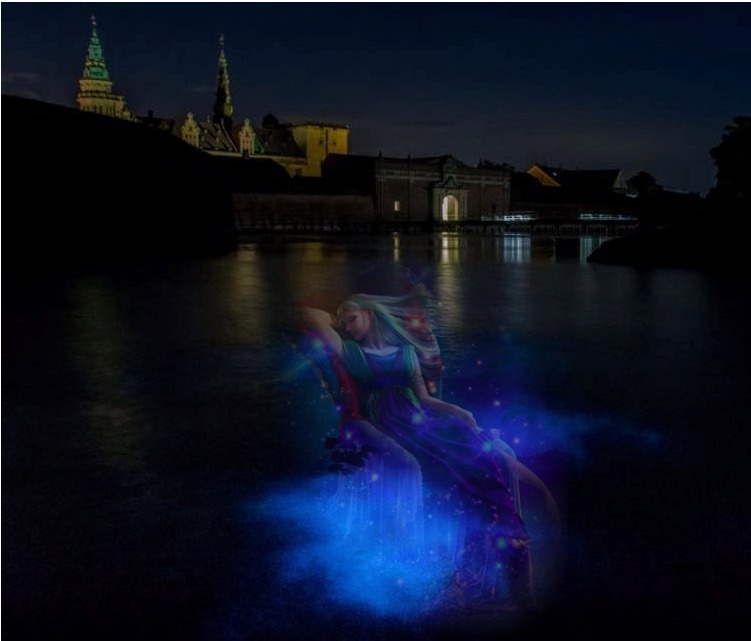 |
| The ghost in the moat, photographed by Esben Garn on
August 20, 2018 at 00:01 |
The Ghost, The Old, Now Dead King Hamlet is often seen walks the ramparts
of "Hamlets Castle"
In 2008, Kronborg reviewed a comprehensive renovation and the old moat was
brought back to their original after being covered for 100 years.
Since then, more tourists and local citizens have seen a light sharpened several
places in the moat around Hamlets Castle. Especially throughout August 2018, it
has been found that the moat, several places brightened sharply around midnight.
Older citizens in Helsingør say that it is the Ghost, the old King Hamlet,
where there are still more secrets to tell about Claudius, others believe it is
the beautiful Ophelia swimming unhappily and restlessly around in the water.
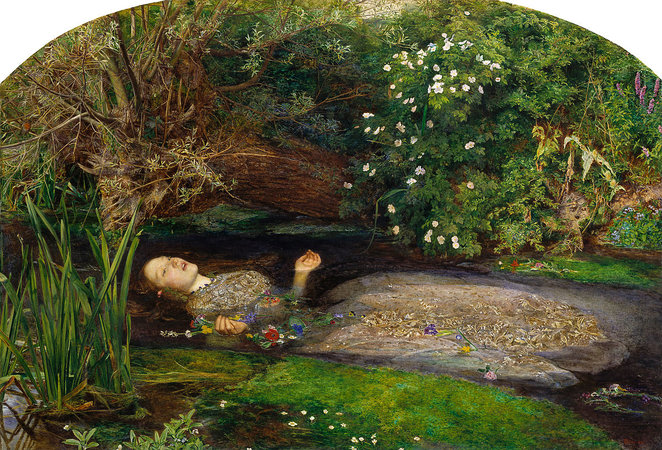 |
| Ophelia painted by John Everett Millais (1852) |
When Prince Hamlet murders Ophelia's father Polonius, Ophelia becomes
insane and drowning herself into the moat while she sings in sorrow and madness.
John Everett Millais has painted the dead Ofelia. The painting is called
Ophelia and was painted 1851-1852.
The painting is fore opservation in Tate Britain in London and reminds much
of what you can be lucky to experience in the moat around Hamlets Castle
Elsinore.
Now where the moat around Hamlet's Castle has been cleaned and brought back to
Prince Hamlet's time, you can be lucky and experience Ophelia singing ind the
moat brighter clearer in different places, exactly after the Cityes Church Clock
has hit 00:00.
Note! "Many turists have photographed Ophelia in the moat with their
I-Phone, but if it's the flash or the modern technology Ophelia does not like,
wee do not know, but use an old-fashioned SLR camera at a very slow shutter
speed.
It's a little creepy, put warm clothes on, YOU GET AWAY SKIN.
Read more about Hamlet
and Shakespeare
Few places in the world is so much drama and history in one place as at Kronborg. Here meet the formidable fortress with the sumptuous Renaissance castle, while Hamlet's spirit floats through the corridors.
No wonder that this very place in 2000 was inscribed on UNESCO's list of the world's inalienable heritage in line with the pyramids, the Acropolis and
The Chinese wall.
It was the Renaissance king Frederik 2. that from 1574 to 1585 was rebuilt the old medieval castle Krogen so that it came to resemble a contemporary princely castle with Renaissance's distinctive, rich decorations.
The goal was that everyone should see what powerful king of Denmark was: The ruler of the Sound.
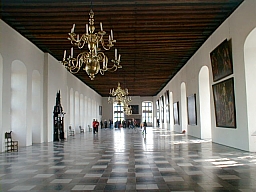 |
| Dansesalen Kronborg Nordeuropas længste riddersal |
The King's mission succeeded. In a few years the castle was imaginative expression, copper-clad roof and spire world famous, so famous that the English playwright William Shakespeare in the late 1500s chose it as the setting for his play, "Hamlet". Inside the castle you can see Frederik 2 and Queen Sophie evocative royal apartment, which was the setting for courtly life for everyday and special occasions when the royal couple took up residence at the palace. From royal apartment you can walk directly into the stunning banquet hall, dance hall, with its 62 meters is northern Europe's longest banqueting hall.
Under the castle is the casemates, a large underground network of corridors and tunnels where soldiers stayed during war and siege. This is where the Danish legendary hero
"Holger the Danish" is sleeping, but will rise to fight if Denmark comes to war.
Every summer, the Kronborg setting for "Shakespeare that Hamlet's Castle", a theater festival with the best Shakespeare Performances from around the world, organized by HamletScenen. Find more about theater festival at www.hamletscenen.dk Read more
about
Kronborg here See and print the sommer
kulturprogram 2016 on the occasion of Shakespeare's anniversary.
The port call: In the Yacht harbor (Marina), located on the alternative route (the wine red line on the map), you
will get close to the maritime Elsinore. Here you will find Elsinore cozy harbor and boardwalk, and not least the Sound aquarium. Embark below the water surface and enjoy the fantastic animal and plant life that is in the Sound.

The Sound Aquarium (Oeresund Aquarium)
 |
| The Sound Aquarium |
Strandpromenaden 5b: GPS: 56.041254, 12.611473
The Sound Aquarium (Oeresund Aquarium) is created to convey wildlife in the Sound characteristic seabed environments.
See the newly renovated biotope aquariums where you from the shallow water sandy bottom put into the depths, the rock bottom fascinating wildlife, mud bottom lofty banks of horse mussels, overgrown with corals and pass over Kullen(Sweden) underwater rocks to end up at the bottom of Elsinore Harbour.
In other major aquariums, you can experience the biggest fish in the Sound and experience the allure of free-floating life of jellyfish aquariums and much more. We have Always a friendly nature guide present in the aquarium.. 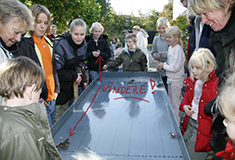
Oeresund aquarium is part of the University of Copenhagen's museums and simultaneously a saltwater aquarium (zoo plant) and a knowledge-educational center in the marine environment with experiences and inspiration to all!
Oeresund Aquarium is an integral part of the Marine Biological Laboratory, University of Copenhagen, and therefore participates also in the many research projects springing from it.
The zookeepers and biologists at the aquarium holds a great experience in how aquatic animals are handled by catch and effort without that they suffer. In the vast majority of research projects are aquarium staff
involved of the one way or another, either directly by capture of the test material, for example. herring shoal experiments in the laboratory, or by animal care and well-being are safeguarded until they possibly. are part of an experimental test in the wet lab.

Shipyard halls and the red Square
Ny Kronborgvej 1: GPS: 56.039049, 12.615400
The old shipyard halls from 1882 stands very authentic and raw as when men in blue overalls working here. Now use Elsinore the halls for events.
See what
happens in Helsingør this sommer.
The Dancing girls (Danserindebroenden)
 |
| The Dancing girls by Rudolph Tegner |
Kronborgvej 8: GPS: 56.038737, 12.612181
The sculpture was designed by sculptor Rudolph Tegner commissioned by brewer Carl Jacobsen, who in 1910 asked the sculptors Edvard Eriksen (1876-1959), Carl Bonnesen (1868-1933) and subsequently also Rudolph Tegner (1873-1950) on the proposal for a memorial, that would honor the ballet. As patron had Carl Jacobsen himself quite firm opinions about the monument's design, and the choice fell on Tegner.
Carl Jacobsen, son of the old brewer Jacobsen who was the founder of the renowned Danish brewery Carlsberg. The son Carl Jacobsen was in the year 1910 very fond of ballet theater and art and even had a large collection of sculpture art. Carl Jacobsen had at that time started its own brewery and competed with his father to brew the best beer.
Carlsber is today one of the world's leading brewers.
Three women/girls from the Copenhagen Royal Ballet stood model for the dancing women at the well. Their names are engraved on the edge: Elna Joergen Jensen Lauesgaard, Emilie Smith and Grethe Ditlevsen. Both the three girls and the well is cast in bronze.
Rudolph Tegner was unhappy with the sculpture's original location in the King's Garden, and asked for the mayor Peder Christensen to propose Danserindebroenden moved to Elsinore. New Carlsberg Foundation handed over the sculpture to Elsinore and 20 March 1934 was The Dancing girls
(Danserindebroenden) in place. It was only in connection with the move to Elsinore, it came to serve as fountains. In the beginning only modestly with a jet of water in the middle of the copper basin, but in 1937 came granite basin to. It was designed by the landscape architect G. N. Brandt (1878-1945) and is part of
the architects landscaping around Danserindebroenden.

SHIPYARD MUSEUM
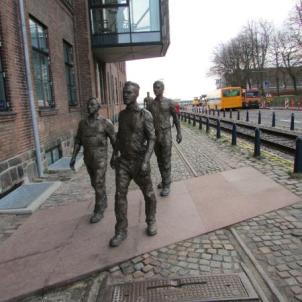 |
| Elsinore Shipyard museum |
Allegade 2: GPS: 56.037676, 12.614263
The museum's exhibits tell about the 101 years in which the city's shipyard built ships and the city's working class grew strong. How the city was ruled by the union.
The Shipyard was founded by M. C. Holm and was one of Denmark's major shipyards. Boatyard period yielded the Sound Extinction Elsinore
the second progress.
The stories from this bygone time is about wear, noise, filth, pride and unity, and about a city where life was guided by shipyard whistle/the Boatyard wing. Both economic, the employment, social, cultural and political were the union
and yard Elsinore a natural point until closing in 1983. Workers Organisation(the union) established headquarters in Elsinore (LO School) and all management positions and political "good bones" was then ruled by the union (LO), which still has great influence on the allocation of "good bones" President and Board positions in the municipality, which meant that incompetente people in management positions, put the city's development to zero.
About Boatyard time we can not say much, just that Elsinore from 1940 until 1985 was dominated by a strong working class and the union has totally paralyzed all development, and the city went from the 50-60serne to be "Denmark Funny Corner" for in 1985 to being on bankruptcy with a number of business closures or relocations. which meant the loss of thousands and thousands of jobs in the city, and today live the city mainly of small-scale trading and tourism, while the majority of residents commute to jobs in Copenhagen
The (positive) is anyway that Elsinore today is with no significant developments in a century, and the city is completely untouched by time, and can tell a unique story about the time during the Sound Dues.
.
H.C. ANDERSEN& LATIN SCHOOL Elsinore
 |
| H. C. Andersen Helsingør |
Kongensgade 12: GPS: 56.037598, 12.610615
H. C. ANDERSEN, Denmark's greatest storyteller spent as a young man two years here in
Store Kongensgade Elsinore, as part of his education and upbringing.
H. C. ANDERSEN loved city life, but his headmaster did years excruciating for the young poet.
H. C. Andersen was born in Odense in 1805. By age 14, he decided to seek his fortune at the Royal Theatre in Copenhagen. In three years he was associated with the theater without a fixed salary until, in 1822, he received his resignation.
That same year, launched H. C. Andersen under the pseudonym his first book - Youthful Attempts. A tragedy of this book the author submitted to the
Copenhagen Royal Theatre.
Hans Christian Andersen's work was rejected, but at the same time the Royal theater initiated to help the young author of an education, after which he received help to complete a grammar school education in Elsinore 1826-29.

Elsinore Grammar School was housed in
Kongensgade 12 in the years 1807 - 39. Denmark's great fairytale writer Hans Christian Andersen, among others known for the story of "The Ugly Duckling", lived and was a student here in the years 1826-29.
The school's headmaster, Simon Maisling, was classical scholar, but his teaching methods did the school years excruciating for the young poet.
The conflict between the two dealt precisely on Andersen's uncontrollable desire to "poems Thing" more than over exact knowledge. And while the young student was tormented by Meislings teaching, tried his mistress, who was notorious for having extramarital affairs, according to historians to seduce the young Andersen.
 |
| H. C. Andersen |
H. C. Andersen was about 1.85 m high - 25 cm higher than the average of its contemporaries. The limbed tall man, the characteristic head with the deep-seated eyes, heavy-lidded eyes and big nose did not fall into the framework of the contemporary ideal of beauty. He applied to be ugly, odd - well, downright repulsive - and his outward form caused a stir and made an awkward and comical impression on most. This was only the first impression. Those who learned the poet to know more closely, got a different impression. They found his face lively and congenial, his stately figure and his appearance elegant. - It could Simon Meisling's wife not resist, but understood love for him.
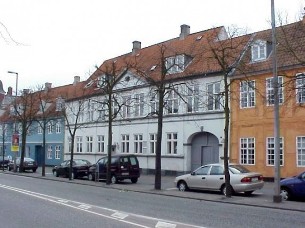 |
| Latinskolen Kongensgade 12 Helsimgør |
Upon his arrival into Elsinore - and before his visit turned into a trauma, H. C. Andersen gave the following vivid description of the contemporary Elsinore: "From the outside road, promised Elsinore me not much, but now I'm inside it, seems to me a small Copenhagen ... What traffic! How lively on the pier, here speaks some thick Dutchmen palm of their language, there I hear the harmonic Italian, further along the coal loader of an English brig, so I think I can smell London. Sound is thronged with ships like sea gulls hovering over the coast. "
The school years, embossed H. C. Andersen, partly by forming partly by fear and inferiority. After examination Artium (1828) published the Hans Christian Andersen his first works under his own name, and after the final 2. Examination (1829) decided the young cand. phil. indulging poet profession at full time.
Read much more about H.C.
Andersen and the poet´s periode in Elsinore
H. C. Andersen ended up completing his secondary education in the capital. And could then focus on his writing, which would make him one of history's most beloved authors. - H. C. Andersen is the author who has been translated into most languages of the world.
The first time of his authorship (1828-1835) is characterized by rich imagination, gaiety and daring, as are grappling with many genres. 1835 was His big breakthrough mainly through the novel "The Improvisatore", but also through the publication of the first adventure: Tales Told for Children. That same year, the poet got his international breakthrough where he in the early days was known and revered for his novel art.
 H. C. Andersen - Meetings with Charles Dickens
H. C. Andersen - Meetings with Charles Dickens
In June 1847 undertook HC Andersen his first visit to England and enjoyed a triumft and social success during the summer. 
The English Countess of Blessington invited the poet to her parties, where intellectual and famous people could meet, and it was at one of the parties he met Charles Dickens for the first time. They shook hands and went out on the porch, which was of great pleasure for H. C. Andersen.
He wrote in his diary: "We went out on the porch and I was so happy to see and talk with England living writer that I love the most." - Ten years later, Hans Christian Andersen visited England again, primarily to visit the Charles Dickens. Hans Christian Andersen lived in Charles Dickens' home for five weeks. shortly after H C Andersen left, Charles Dickens published David Copperfield, "featuring servil Uriah Heep", which is said to have been inspired by Hans Christian Andersen.
The highlight of the Hans Christian Andersen's career took place in Germany in 1846 and England in 1847, where he was hailed the most sumptuous. Despite the matchless recognition abroad, Hans Christian Andersen angry opponents in Denmark.
At the Royal Theatre had the poet his greatest battles and defeats, but once the theater's monopoly was abolished, could H.C. Andersen celebrate his popular breakthrough in Denmark at the theater Casino.
Much of Hans Christian Andersen's stories were re-filmed by Walt Disney in 1941.

AXELTORV AND TRADE LIFE
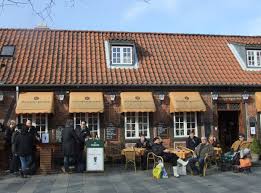 |
| Gaestgivergaarden Axeltorv |
Axeltorvet: GPS: 56.036106, 12.610540
Axeltorv is Elsinore´s popular venue. Here you get the impression of a Mediterranean atmosphere in the summer, when cafes and restaurants move outdoors and serves mouthwatering cold beer. Other days you can pull in some of the old taverns that surround the square. - Gaestgivergaarden as you see in the picture to the right, is one of
Elsinore's oldest restaurants - When the restaurant has had the same owner for over 40 years. it means good food.?
In December you can experience true Christmas spirit with the city's Christmas tree, Christmas market and everything else belonging to Christmas.
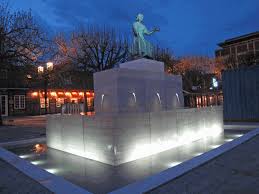 |
| Erik of Pommeranias Memorial Fountain |
In the middle of the square stands Erik of Pomerania Memorial Fountain. Erik was a handsome man, tall with bright yellow hair, an erect position. A womanizer who in a tag could soar up on the horse.
On front of the memorial Fountain is written "My hope is in the sea". Around the pedestal is the text: "D. June 2, 1426 assigned King Eric to Elsinore privileges as a market town. Erik of Pomerania introduced at the same time Sound Dues and built the castle Kronborg and the Carmelite Monastery ".
In late 1300 took over Erik of Pomerania, the largest Nordic kingdom ever. He was at one time king of Norway, Sweden and Denmark and his ambition was to build a Baltic Empire.
It did not succeed. Due to wars and social unrest, he ended up losing it all and was deposed as king.
 |
| Under Erik of Pommeranias Memorial
Fountain |
The excavation under Erik of Pomerania Memorial Fountain in 2013, showed unexpectedly well preserved layers from the late middle ages and Renaissance, which was due to the replenishment estimates were unusually thick at this location. The excavation tells a detailed story from the oldest layers from the 1400s, the site lay as a swamp and was used for the disposal of slaughter waste, a charge broken pot tiles and little shoes waste. Around 1500, the area was undeveloped by applying a half meter beach sand.
On top of this is laid a stone paving, which presumably has been a kind courtyard. From then through the 1500s and early 1600s, the city has used the area for metal handling of various kinds.
The square's history dates back to the late 1600s. In 1884 burned Jørgen Holm farm in the inner city and in this connection the city got the opportunity to create a real town square, which was subsequently extended to the present area.
Fra torvet bevæger City Walk ruten sig ind i byens gågader. Som det fremgår
af kortet øverst, er der flere veje man kan vælge.

Sct. Olaigade Café
Olai
 |
| Sct. Olaigade 1 - 3 - 5 og 7 |
Sct. Olaigade 19: GPS: 56.034757, 12.610175
Sct. Olai Gade constituted the middle part of the east-west streets that were the backbone of Erik of Pomerania's urban plan. Therefore was the street for hundreds of years named "The Between street."
In the 1830s the street was extended north of St.Olav's Church, where a former path of the city's former main cemetery, St. Olav's herb garden, received the status of a public road. The street was now named St. Olaigade, and in the early 1900s was
St. Olaigade extended to the entire sequence of streets from Sct. Olav's Church to
Fiolgade
The houses in Sct, Olaigades South end. from no. 1 - 3-5 - 7 - 9 is smaller townhouses in private ownership, but we will approach the contemporary urban area
(Stjernegade) changes the houses character to be residential and crafts, warehouses and trade.
St. Olav's Street no. 19 (Sct. Olaigade 19) is one of the oldest and was once a shoemaker fabrik and workshop.
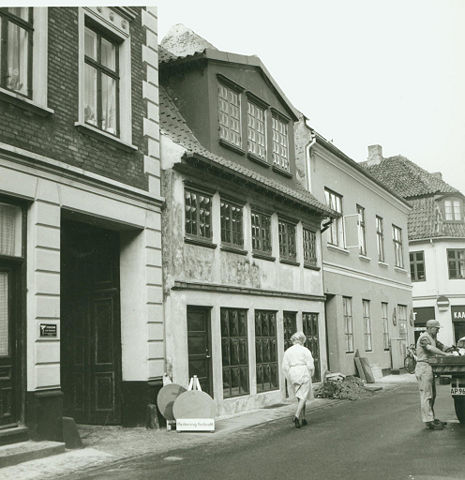 Listening Central during the war in 1944: Karl Otto Bakowski had fled from Germany after the Reichstag fire in 1933. He had since occupation lived in hiding in Elsinore in
Sct. Olaigade 19 at shoemaker Larsen. Here discovered Bakowski a "dead" phone cable, which he thought could be used against the Germans.
Listening Central during the war in 1944: Karl Otto Bakowski had fled from Germany after the Reichstag fire in 1933. He had since occupation lived in hiding in Elsinore in
Sct. Olaigade 19 at shoemaker Larsen. Here discovered Bakowski a "dead" phone cable, which he thought could be used against the Germans.
 |
| Painting nr. 4 |
With the help of the Danish telephone engineer C. B. Hansen, connected Bakowski
the line to a homemade listening device. After further intervention in the telephone exchange in Elsinore could Bakowski listen to the Gestapo headquarters in Elsinore. Conversation became so sophisticated that Bakowski could intercept all the Gestapo centers throughout North Zealand.
Germans Gestapo headquarters in Elsinore had in secrecy planned to arrest 14 named resistance fighters in Hilleroed night of Friday, 29/12/44, but when Gestapo kicked the doors in to the specified addresses, the bird was flown and the Gestapo caught not one.
As Bakowski understood the German abbreviations and military terms, the Danish resistance
poeple could not find a replacement for him. Therefore, he used often up to 22 hours a day by listening. Bakowski find out which arrests the Gestapo planned, and making lists to the resistance groups.
Bakowski even thought that the most important information he got was Sept. 19, 1944, when the Gestapo planned arrest of the Danish police. Bakowski managed to convey a warning that saved many officers from being arrested by the Germans.
Sct. Olai Gade 19 was renovated in 1983 and has since been Restaurant Café Olai.
Restaurant Café Olai with more than 30 years behind in Elsinore, is today an institution in the city and reflects the old Elsinore in both atmusfære as interior, and even the prices are for 1/4 century ago
Café Olai has a neat renumé that goes far beyond its borders and is one of the best eating places in Elsinore, the restaurant is mentioned regularly in the magazines, Travel News and Globetrotter, as part of Elsinore's culture.
The legendary restaurants is well attended and especially around noon. 13:00 to 15:00, there may be Queuing to reserve a table, therefore came in good time, or schedule a later visit. Tel. +45 49 20 16 07
In the restaurant is also tourist brochures, city walk suggestions, or you can ask the staff.
(by the way,? are you wondering why Danes eat dark rye bread), read here
A
taste of Denmark
If you have cell phone you can download or open this walking tour on
/elsinore-city-walk.aspx

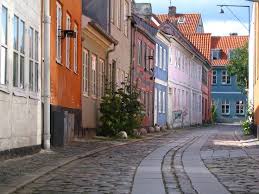 |
| Soestraede against Sct. Olaigade |
Soestraede 13: GPS: 56.034398, 12.609649
When you leave Sct. Olai Gade then turn a trip down to the cobblestones in
Soestraede
Disabled can continue left onto Fiolgade a little further.
Most houses in Soestraede can be traced back of 15 - 1700.
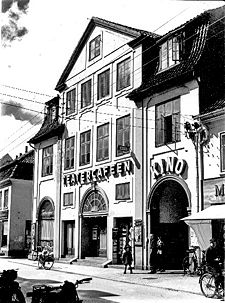 |
| Theatre café with access from Stengade 37 |
The property Sea Street (Soestraede) 2 was in 1753 used as a tannery, but in 1792-93, the building was designed as an English church.
Elsinore was known as "Denmark's happy corner" and in 1837 sold the church this property to the amusement establishment with ballroom under the name "Babylon", cinema and cafe. In 1913 bought the workers' union (LO) the property
Stengade 37/Soestraede 2, so that they now have a corner property. Here was established the cooperative "Picture Theatre," which was a great success.
There was performed the "Elsinore Revue" from 1915, and most of Denmark's popular actors and movie stars have left their mark on "Elsinore Theatre" as the establishment for years was called.
The popular Danish actress Bodil Udsen's first major hit song and breakthrough was "Flute barrel Viktoria" which she argued for the first time in Elsinore Revue in 1956th
Elsinore is still "Denmark Funny corner" and in the Old Theatre, is now home to "Old Irish Pup" which is the most popular Pup, Disco, Nightclub in North Zealand, with a nice and mature audience.

Stengade Elsinore's main street
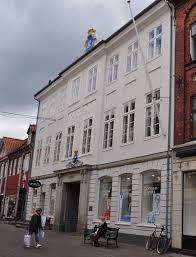 |
| Skydeselskabet Helsingør |
Stengade 46: GPS: GPS: 56.034230, 12.611806
The fine property on Stengade 46 at Elsinore's main street was completed 1791. It was in this building that Napoleon's marshal, Jean Baptiste Bernadotte,
at October 19th, 1810 renounced his Catholic faith, for the day after going ashore in Helsingborg as the Swedish crown prince. In 1817 he became king of Sweden under the name Carl 14. Johan.
Some years later took over the Swedish government this building, which until the late 1840s served as a consulate courtyard. The property was built by the Swedish Consul General Isaac Glörfeldt. Architect was C. F. Adelcranz, who also was Swedish.
The building is an early representative of classicism in Elsinore. The facade consists of three parts with the center portion highlighted. The building is crowned by a mighty shield decoration with Gustav III's monogram, which was Sweden's king, when it was built.
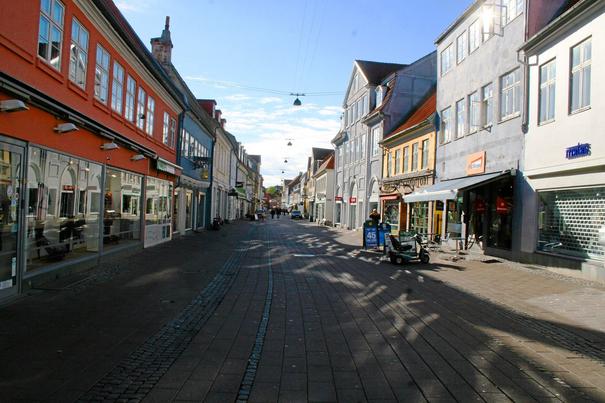 |
| Stengade 40 |
Since 1901 the building has been the headquarters for Elsinore Royal Privileged Shooting Society, which in 2015 celebrated its 250 anniversary. The original purpose of the Society was to give members marksmanship, which could contribute to homeland defense. Today the Society is more sociable character. All monarchs since Christian 7 has been a member of the Society. Today, Prince Henrik, who is married to Denmark's Queen Margrethe member.
 |
| Stengade 20 |
Stengade 40:
"Jochm Langen House" inscription in Low German over the door means translated: "This house has the honest man, Jochm Langen had built in the year 1604 d. 3.feb. Where God does not give his blessing to the house, working all in vain. "Also note here the cutouts in the woodwork.
Stengade 20:
Mayor Iver Pedersen's farm on the corner of Sagittarius Strait is from 1600. The building is one of the few remaining of the many half-timbered houses from the Renaissance Elsinore. Note the carved keel arches, flowers and acanthus leaves in the woodwork.
Turn right onto Fiolgade and go left at Monk Street.(Munkegade)

THE EX. ABBEY IN MONK STREET
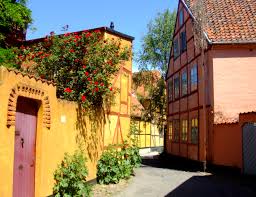 |
| Munkegade Monk Street |
MunkeGade 11: GPS: 56.033492, 12.608834
When you turn in at Monks street(Munkegade) and Black Friars streit, is like getting into a small time break. Here, where today is homes, was in the Middle Ages a monastery which belonged to the Dominican order, the so-called Black Friars. The name comes from the black cloak which they were clothed outdoors.
The monks were given in 1425 by King Erik of Pomerania the donated property "for everlasting possession, which they might build" church, monastery, brick barn and other houses which are those utility right, orchard, hop yard, cabbage yard and garden. "
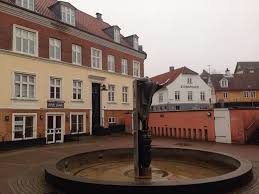 |
| Simon Spies Plads |
After the Reformation, the king gave monastery and due to the establishment of a hospital. It was 1567 gradually demolished. In Sortebrødre Alley, going on the right side of the settlement, the cobbles is the same as the monks' time.
At the end of Monk Street(Munkegade), turn left onto Klostergade the direction of the city Mall's main entrance and Simon Spies Square.
Simon Spies Square: The square is named after Simon Spies (1921-1984). He was called "Danish travel king" because he was a pioneer in the field of package holidays and the Danes were to go on holiday abroad. He was born and raised in modest circumstances in Elsinore. The square was named after him in 1992.
Simon Spies Square lies at Svingelport, as in the old days was the access road to Elsinore from land. Here was an office where the duty was due on all products, which were brought in from the countryside.
Cross now Stengade and continue on Golden Street to Anna Queens Strait
on the left.

Flea market
Just around the corner, every Saturday between 09:00 and 15:00 from 6 May to 30 Sept.
Simon Spies Plads and Swingport embrace of life and street trade, as was it Portobello Road
ANNA QUEENS STRAIT
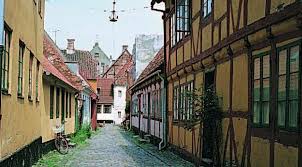 |
| Anna Queen strait Elsinore |
Anna Queens Straede 1 : GPS: 56.032361, 12.609574
This fine little cobbled street is one of the oldest and has been here since the 1600s. At that time was called
"Moellestraede by Svingelen" and the "small Moellestraede".
Strait's current name has nothing with the royal to do. But is because the merchant family Quie, who in the 1700s owned several properties on the street.
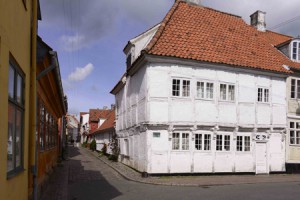 |
| Strandgade 27 Oldest house in Elsinore |
The name Anna Queen was in fact Quie surname and was the widow of grocery Hans Quie.
Turn right onto Gunner Strait(Skyttensstraede) at the end of Anna Queens Strait and then left onto Strand
Street(Strandgade).
On the corner you will find at Strand Street 27(Strandgade 27), the oldest preserved half-timbered house in Elsinore.
Peter in the anchor's Daughter, Beach Street 27(Strandgade 27). This very well kept property on two levels has the year 1577 carved on a piece of wood over the window field in the door facing Strand Street. The field with the door and subject to the right for this, the former carriage house. The upper storey overhanging the ground floor and is supported by beautifully carved brackets. These are completed with helical end in jargon called volutkonsoller and decorated with carved
acanthus leaves. Between brackets the timber is cut keel as arcs, that means, designed as cross-section of an inverted boat.
This style and decoration form was typical of Elsinore timbered houses, when the house was built.
The property was partly inhabited by several ferry men. It also housed the tavern "Peter the anchor's Daughter" or "anchor" that existed for many years.
Strandgade- from southwest to northeast
Strand Street(Strandgade) is several centuries younger than Stengade.
The beach line has previously been closer to Stengade and first with the construction of a wall facing the water in 1620 began the area to get the character of a street.
Strandgade 1:
The house was built in 1760, and the have until the Sound Dues elimination in 1857 always been inhabited by ferry men, including from 1801-1817 the bold and infamous pirate, privateer and adventurer Jens Lind, who was especially known for his fearless effort in the war against England in 1807-14 and for a voyage to Russia in snowstorm in a small open boat.
Strandgade 19-21:
Once housed the inn and tavern "Norske Lion." The house was built in 1770 by a ferryman and over the 1800 and 1900 been rebuilt several times. In late 1980, when 19 were markedly separated from 21 and got its original timbered facade back. The process is a good example of how the old houses in Elsinore restored in cooperation with the conservation department of the municipality.
Strandgade 27: described above
Strandgade 39:
Nowadays a modern house. An earlier house on the site was from 1700 and was owned for long periods of a number of Elsinore Jews. Around 1800, it was the Jewish school and synagogue .
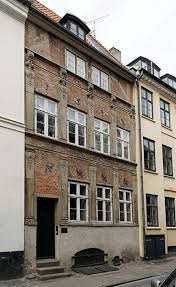 |
| Strandgade 55 |
 Strandgade 55: GPS: 56.033782, 12.612447
Strandgade 55: GPS: 56.033782, 12.612447
Badskaer Jacob Willumsen's farm is a Renaissance house built in 1592 straight after the construction of Kronborg and we believe it is one of Frederick II's Flemish craftsmen who have been at stake here.
The house is probably one of Elsinore's most beautiful Renaissance houses and is Grade II Listed, Over neighboring house,
Strandgade 53, you can see a wing rod with three crowns over each other. They testify to the 100 years after 1750, when the property housed the Swedish Consulate General.
Strandgade 71:
Marstrand Ship Chandlers from 1847 is a fine example of a business from the Sound Dues time. .
Strandgade 77-79:
The old "Swan Pharmacy". The original house dates from around 1500 and built in the late Gothic style. From 1578 it was the city pharmacy. On the facade seen swans and a sundial. Wall anchors form the year 1634 and the initials of the builder, councilor Johan Kruse and his wife. The house only ended to serve as pharmacy around 1970th

Diderik Buxtehude
 |
| Buxtehude |
Buxtehude was an Sound citizen
In the years 1638-41 seemed Buxtehude the elderly in Helsingborg and here spent Diderik some childhood years. In 1642, got his father served as organist at St. Olav's Church in Elsinore, where he was active until 1670. Children and youth spent Diderik Buxtehude ie both in Elsinore and Helsingborg.
 |
| Buxtehude |
Varied musical life
In the 1600s, the first half was the musical life at the Danish court and in the larger churches of very high class. Names like Heinrich Schütz and John Dowland is transferred to the history of music. Schütz was church musician in Copenhagen and established court chapels.
Dowland, famous lute player and composer, was court musician and lived in Elsinore. Johann Lorentz worked in the first half of the 1600s as a royal organ builder and built, or rebuilt all major organs in the Oresund region in as quite conservative renæssanse style as was represented by Heinrich Schütz and John Dowland. One of the most important testimonies of Lotrentz company found in organ façade of Christianstads Trinity Church Sweden.
 |
| Mariakyrkan i Helsingborg |
Organist round-trip
Diderik Buxtehude went in his father's footsteps and became in 1657 organist of St. Mary's Church in Helsingborg. In 1660 he sought and got the post of organist at St. Mary's Church in Elsinore. Presumably because this office was better paid and he thus came closer to the rest of the family. In the period up to 1668, where Buxtehude traveled to Lübeck and looking for work. at that time he lived in the same house as the father and the mother. The house still exist in Elsinore Skt. Annægade.
 |
| Det gamle orgel |
At the same time, there was a modernization of the old Lorenz organs for a modern Baroque style, a style represented musically by Diderik Buxtehude. The North German organ builder Hans Christoff Frietzsch stood for this modernization and he was the man behind the renovation and new construction of organs in Copenhagen, Elsinore, Halmstad, Helsingborg, Landskrona and Malmö.
Diderik Buxtehude saw so and participated in a very active renewal of musical life through the new buildings that were made. Two years after he had moved to Elsinore, he returned to Helsingborg (1662) to oversee the rebuilding of the organ in St. Mary's Church. This suggests that the Swedish takeover of Scania in 1658 has not directly affected the musical life.
 |
| Sct. Annægade |
The connection is maintained
During his time in Elsinore Buxtehude maintains close relations with both Danish and Swedish official citizens. The only full safety famous piece of music by Buxtehude has written during his time in Elsinore is in the year 1665 dedicated to Christopher Schneider, who was Swedish postmaster and later kommisarius resident of Elsinore. Also had Buxtehude already from Elsinore-time friendly relations with the Swedish court Kapellmeister and organist Gustav Buben. Perhaps it is also at his request to Buxtehude in 1680 composes wedding cantata for the wedding between Charles 11.Gustav and his Danish-born Queen Hedvig Eleonora.
The time in Lübeck
1668 moved Diderik Buxtehude to Lubeck, presumably for the sake of his future career, but probably also to get away from the tight economic conditions in the war-torn Øresund Region. As a common thread in Buxtehude's lives are the three maria churches in Helsingborg, Helsingor and Lubeck. Although most of his active life was moved to Lübeck and although he won the greatest honor and fame, he never forgot his roots in the Sound Region. Therefore, the journal Nova litttraria Maris Balthici year 1707 claim that "he considered Denmark for his homeland" (Patriam agnoscit Daniam).
Diderik Buxtehude's career as a composer and organist culminated in Lübeck, to which large composers like Handel and Bach walked to listen to his music. It was as organist and composer in Mary's Church in Lübeck he won his great fame. He was particularly known for his "Lübecker Abendmusik" which was concerts related to the evening song Sundays before Christmas. To these he wrote every year a new organ work.
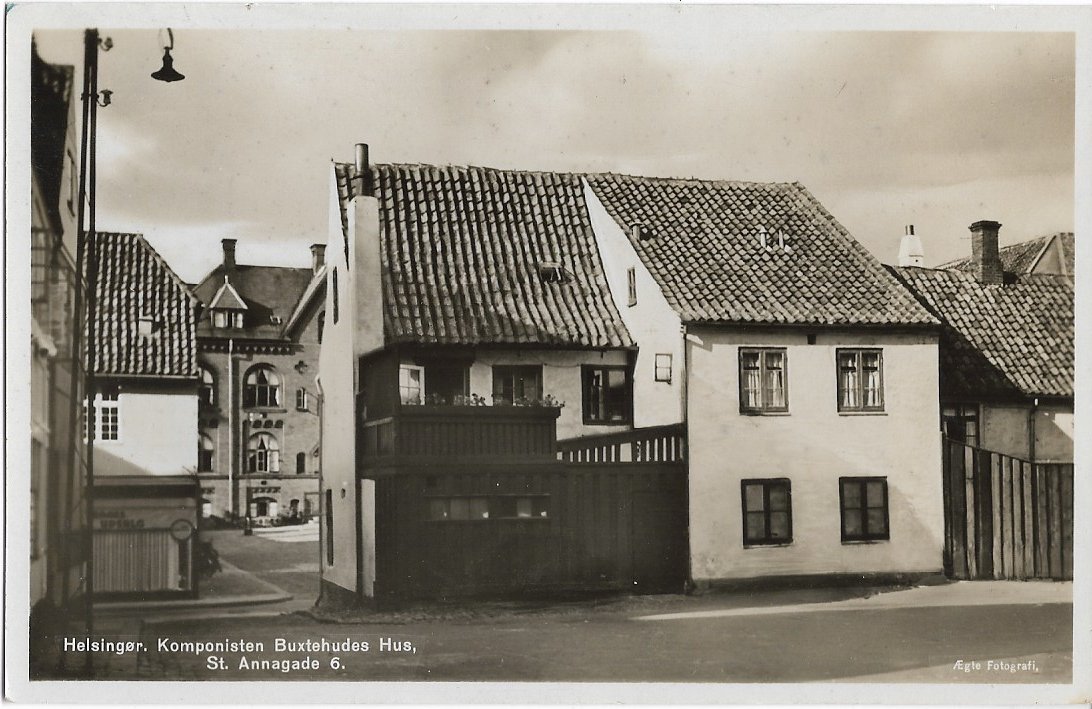 |
| Sct. Annaegade 6 |
In St. Annagade 6, Elsinore, is Dietrich Buxtehude's childhood home, a small old house that is unknown to most Danes, but which should be celebrated as the H. C. Andersen House in Odense.
This is the place where our world-famous Danish composer Diderik Buxtehude lived.
There is not a Conservatory or University in the world where students do not learn about Buxtehude. He was the organ's greatest master before Bach.
Denmark his, native country does not make much effort to cherish his memory.
Read
more about Dietrich Buxtehude here
